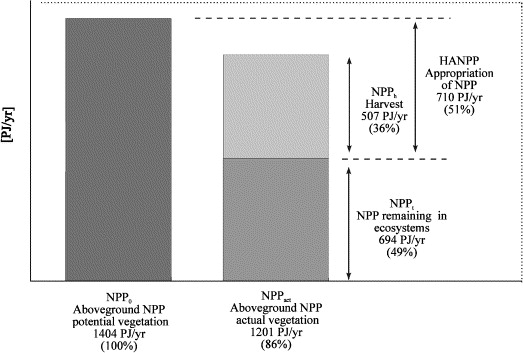Humans depend on land and the resources it provides for their subsistence. Plant biomass is one of the most important of these resources. Humans depend on it for: food directly and as feed for livestock, other energy (e.g. firewood, agrofuels), paper pulp and construction material as well as other ecosystem services such as retaining water, maintaining soil and storing carbon. In addition, humans also depend on land for infrastructure and living space and for all these purposes alter natural land cover, reducing its vegetative productivity, as well as destroying and extracting biomass, hence reducing the energy available for other species. Biomass-based subsistence economies, are those in which communities depend almost entirely on local biomass for their survival.
The impact of human colonisation of natural processes on the biosphere’s structures (e.g. land cover) and functioning (e.g. biogeochemical cycles) is considerable, exceeding natural variability in many cases (Crutzen and Steffen, 2003). Up to 83 percent of the global terrestrial biosphere has been classified as being under direct human influence, based on geographic proxies such as human population density, settlements, roads, agriculture and the like (Sanderson et al. 2002). Hannah et al. (1994) estimate that about 36 percent of the Earth’s bio-productive surface is ‘entirely dominated by man’.
HANPP, the Human Appropriation of Net Primary Production, is an aggregated indicator (introduced by Vitousek et al. in 1986) that reflects both the amount of area used by humans and the intensity of land use (Haberl et al., 2007a). HANPP measures to what extent land conversion and biomass harvest alter the availability of trophic (biomass) energy in ecosystems. It is a prominent measure of the ‘scale’ of human activities compared to natural processes (i.e. of the ‘physical size of the economy relative to the containing ecosystem;’ Daly, 2006: 1). It is an indicator of pressure on biodiversity.
Haberl (1997) proposed a definition of HANPP that has proven its usefulness in spatially explicit as well as long-term (e.g. Krausmann, 2001) studies on a national scale. HANPP is defined here as the difference between the amount of net primary production (NPP) that would be available in an ecosystem in the absence of human activities (NPP0) and the amount of NPP which actually remains in the ecosystem, or in the ecosystem that replaced it under current management practices (NPPt). NPPt can be calculated by quantifying the NPP of the actual vegetation (NPPact) and subtracting the amount of NPP harvested by humans (NPPh) (Haberl et al., 2007a). NPPh includes primary crop harvest but also harvest losses, i.e. residues or biomass destroyed during harvest, grazing and humaninduced fires. Based on the above HANPP is therefore defined according to the formula:
HANPP = NPP0 – NPPt with NPPt = NPPact – NPPh.
The difference between NPP0 and NPPact represents the reduction of NPP0 through the conversion of natural land cover to other types of land cover, i.e. the land use induced productivity changes which one denotes as ΔNPPLC (Haberl et al., 2007b). HANPP is therefore also equal to NPPh +ΔNPPLC.
In order to calculate HANPP (see Figure 1), information is needed on the development of land use, productivity of vegetation, biomass harvest and related harvest factors. This is provided through agricultural and land use statistics, yearly productivity values and agricultural literature.
Implications of HANPP
Growth in the amount of biomass used by humans for their socioeconomic metabolism implies less biomass availability for other species. Biomass already plays a significant role in global socio-economic energy supply, currently contributing some 9–13 percent, that is 35–55 EJ/yr (1 EJ = 1018 Joule), to the global supply of technical energy (fuelwood, agrofuels). This figure, however, by far underestimates the importance of biomass for humanity’s ‘energetic metabolism’: Global human biomass harvest, including crops, by-products, grazing by livestock, fibre consumption and forest products amounted to about 235 EJ/yr around 1993. Notable future increases in biomass demand are expected. The projected growth of world population (until ‘peak population’ is reached in about 2050), together with likely changes in human diets towards meat consumption, are strong driving forces for further increases in the amount of biomass required as food and feed. Moreover, many energy scenarios also envisage increases in the amount of biomass used for energy provision other than food.
HANPP alters energy flows within food webs and based on the species energy hypothesis has been hypothesised to contribute to biodiversity loss (Wright, 1990). HANPP is relevant in the context of global water flows (Gerten et al., 2005), carbon flows (e.g. DeFries et al., 1999) and nitrogen (N) flows as biomass contains N, and N fertiliser is an important factor for agricultural productivity. It also relates to important global sustainability issues such as endemic malnourishment of a large proportion of world population (FAO, 2005), the ongoing conversion of valuable ecosystems (e.g. forests) to infrastructure, cropland or grazing land (see e.g. Millennium Ecosystem Assessment, 2005) with detrimental consequences for biodiversity (Heywood and Watson, 1995), and global, human-induced alterations of biogeochemical cycles (e.g. Steffen et al., 2004; Haberl et al., 2007a).
In addition to looking at HANPP in relation to a certain territory, it is also useful to investigate the HANPP embodied in certain biomass-based products (see Haberl et al., 2009). Products derived from using land and appropriating biomass are seldom consumed locally or domestically but are often produced for export. Therefore, some countries or communities might have a high HANPP on their territory but this might not actually reflect their consumption of HANPP. Alternatively, the environmental impacts on a particular territory might not stem from local consumption. Embodied HANPP reflects this disconnect between areas of production (and therefore appropriation of biomass) and NPP and consumption of final products.
References
Crutzen, P. J. and Steffen, W., (2003) How long have we been in the anthropocene era? Climatic Change 61 (3) 251-257.
Daly, Hermann, E. (2006) The concept of scale in Ecological Economics: Its relation to allocation and distribution. Internet Encyclopedia of Ecological Economics [online] URL: http://www.ecoeco.org/publica/encyc.htm, International Society for Ecological Economics (ISEE).
DeFries, R. S., Field, C. B., Fung, I., Collatz, G. J., Bounoua, L. (1999) Combining satellite data and biogeochemical models to estimate global effects of humaninduced land cover change on carbon emissions and primary productivity. Global Biogeochemical Cycles 13(3) 803-815.
FAO (2005) Assessment of the World Food Security Situation, Food and Agricultural Organisation of the United Nations. Committee on World Food Security, 23–26 May 2005, Rome. Available at: http://www.fao.org/docrep/meeting/009/j4968e/j4968e00.htm.
Gerten, D., Hoff, H., Bondeau, A., Lucht, W., Smith, P., Zaehle, S. (2005) Contemporary “green” water flows: Simulations with a dynamic global vegetation and water balance model. Physics and Chemistry of the Earth, Parts A/B/C 30(6-7) 334-338.
Haberl , H. (1997) Human appropriation of net primary production as an environmental indicator: implications for sustainable development. Ambio, 143-146.
Haberl, H. et al. (2009) Using embodied HANPP to analyze teleconnections in the global land system: Conceptual considerations. Danish Journal of Geography 109(2):119-130.
Haberl, H., Erb, K.H, Krausmann, F. (2007a) Human appropriation of net primary production (HANPP). The Encyclopedia of Earth [online] http://www.eoearth.org/article/Global_human_appropriation_of_net_primary_production_%28HANPP%29. Last viewed November 11, 2012.
Haberl, H., Erb, K.H., Krausmann, F., Gaube, V., Bondeau, A., Plutzar, C., Gingrich, S., Lucht, W. and Fischer-Kowalski, M. (2007b) Quantifying and mapping the human appropriation of net primary production in earth’s terrestrial ecosystems. Proceedings of the National Academy of Sciences, 104:12942-12947.
Hannah, L., Lohse, D., Hutchinson, C., Carr, J. L., Lankerani, A. (1994) A Preliminary Inventory of Human Disturbance of World Ecosystems. Ambio 23 (4-5) 246-250.
Heywood, V.H. and Watson, R.T. (1995) Global Biodiversity Assessment. Cambridge, Cambridge University Press, United Nations Environment Programme (UNEP).
Krausmann, F. (2001) Land Use and Industrial Modernization: an empirical analysis of human influence on the functioning of ecosystems in Austria 1830 – 1995. Land Use Policy 18 (1) 17-26.
Millennium Ecosystem Assessment (2005) Ecosystems and Human Well-Being, Synthesis. Washington, D.C., Island Press.
Sanderson, E., Jaiteh, M., Levy, M., Redford, K., Wannebo, A., Woolmer, G. (2002) The human footprint and the last of the wild. BioScience 52 (10) 891-904.
Steffen, W., Sanderson, A., Tyson, P. D., Jäger, J., Matson, P. A., Moore III, B., Oldfield, F., Richardson, K., Schellnhuber, H. J., Turner II, B. L., Wasson, R. J. (2004) Global Change and the Earth System. A Planet Under Pressure. Berlin, Springer.
Vitousek, P. M., Ehrlich, P. R., Ehrlich, A. H., Matson, P. A. (1986) Human Appropriation of the Products of Photo synthesis. BioScience 36 (6) 363-373.
Wright, D. H. (1990) Human impacts on the energy flow through natural ecosystems, and implications for species endangerment. Ambio 19(4) 189-194.
For further reading:
Ayres, R. U. and Simonis, U. E. (1994) Industrial Metabolism: Restructuring for Sustainable Development. Tokyo, New York, Paris, United Nations University Press.
Fischer-Kowalski, M. and Haberl, H. (1997) Tons, Joules and Money: Modes of Production and their Sustainability Problems. Society and Natural Resources 10 (1) 61-85.
Haberl, H., M. Fischer-Kowalski, F. Krausmann, H. Weisz, V. Winiwarter (2004) Progress towards sustainability? What the conceptual framework of material and energy flow accounting (MEFA) can offer. Land Use Policy 21 (3) 199-213.
Hall, C.A.S., Cleveland, C.J., Kaufmann, R.K. (Eds.) (1986) Energy and Resource Quality, The Ecology of the Economic Process. Wiley-Interscience, New York.
Imhoff, M. L., Bounoua, L., Ricketts, T., Loucks, C., Harriss, R., Lawrence, W. T. (2004) Global patterns in human consumption of net primary production. Nature 429 870-873.
Rojstaczer, S., Sterling, S. M., Moore, N. (2001) Human Appropriation of Photosynthesis Products. Science 294 (5551) 2549-2552.
Weisz, H., Fischer-Kowalski, M., Grünbühel, C.M., Haberl, H., Krausmann, F., Winiwarter, V. (2001) Global environmental change and historical transitions. Innovation: The European Journal of Social Science Research 14 (2) 117–142.
Whittaker, R. H. and Likens, G. E., (1973). Primary Production: The Biosphere and Man. Human Ecology 1 (4) 357- 369.
This glossary entry is based on contributions by Willi Haas, Simron Jit Singh and Annabella Musel
EJOLT glossary editors: Hali Healy, Sylvia Lorek and Beatriz Rodríguez-Labajos






Pingback: The State of the Human – Part 1: The Bright Side | Unfolding Human